Sweetgreen’s Infinite Kitchen opened in Naperville, Ill., on May 10 and, as the restaurant chain reported in its latest earnings call for the period ending on June 25, it has already seen massive success.
The Infinite Kitchen is an automated restaurant that, using Spyce technology that Sweetgreen acquired in 2021, has bowls moving down a conveyer belt. Guests pick out their food that way.
The unit is not entirely devoid of humans, however. There is a host — a new position for the fast-casual brand — who is meant to assist customers. There are also humans at the end of the makeline adding herbs and/or avocado.
The restaurant-level margins for the store were 26%, above the chain’s average of 20.4%. That’s anomalous for an industry that’s broadly seeing negative restaurant-level margins.
Jonathan Neman, CEO of Sweetgreen, is attributing that to better labor deployment as well as improvements in supply chain sourcing.
As far as the cost of the Infinite Kitchen if it were to be rolled out across the country, Neman said, “the machines do have an incremental investment, but we believe we actually know that they will deliver an accretive return on capital anywhere we put them.”
Sweetgreen will be opening a second Infinite Kitchen at the end of this year, according to Neman.
“We’re getting a lot of positive feedback on everything from the theater of the food, really showing the scratch cooking, the hospitality, the speed of service, and the portioning and accuracy,” said Neman. “So it does solve a lot of customer experience challenges that exist in the restaurant industry.”
Though Neman would not reveal how much the Infinite Kitchen costs, he did say that the chain would only be rolling it out where they see “incremental accretive return on capital.”
When Neman announced the new prototype in November 2022, he was confident that the restaurant would cut labor in half and increase order accuracy.
“As you can expect, machines make these things perfectly,” he said at the time.
For its most recent quarter, Sweetgreen saw same-store sales rise by 3%, versus 16% the year prior. Loss from operations was $31.2 million and loss from operations margin was 20%, versus loss from operations of $42.7 million and loss from operations margin of 34% in the prior year period. Total revenue was $152.5 million, versus $124.9 million in the prior year period, an increase of 22%.
Adjusted EBITDA was $3.3 million, versus Adjusted EBITDA of negative $7.8 million in the prior year period; and adjusted EBITDA margin was 2%, versus negative 6% in the prior year period. This is the first time the chain posted positive EBITDA numbers since becoming a public company in October 2021.
The chain, which released its first-ever loyalty programs called Sweetpass and Sweetpass + during the quarter, saw its total digital percentage decrease year-over-year. Last year, the total digital revenue percentage was 62% for total digital revenue and 40% for owned digital revenue. This year, total digital revenue was 59% and owned digital revenue was 37%.
Neman said that the chain has seen success with the app, but that most customers are still going to the store rather than placing an order on the app.
“Our biggest channel and our fastest growing channel right now is our in-store business, and Sweetpass today does not work in-store,” said Neman.
However, the chain is working on a way for customers to use Sweetpass in stores.
In Q2, the chain opened 10 net new units, an increase from eight the prior year. Those 10 units bring Sweetgreen’s total stores to 205.





